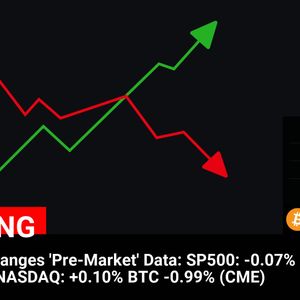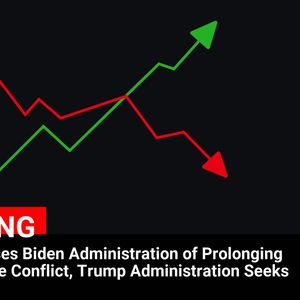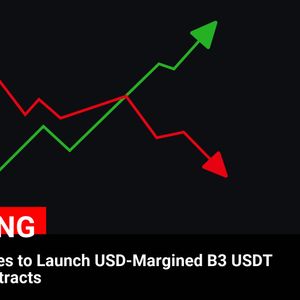Bitcoin’s market dynamics continue to evolve as institutional adoption and macroeconomic factors shape its long-term trajectory. Recent data from ARK Invest highlights Bitcoin’s aggregate cost basis reaching a record $40,980, underscoring growing investor confidence and a potential long-term support level. At the same time, projections for Bitcoin’s future price remain optimistic, with ARK Invest CEO Cathie Wood reaffirming the firm’s $1.5 million bull case, driven by increasing institutional exposure. While short-term volatility persists amid economic data releases and geopolitical tensions, analysts point to key indicators—such as the 200-week moving average and Bitcoin’s dwindling exchange reserves—as signs of resilience and potential future growth. Bitcoin’s Path to $1.5 Million Gains Momentum as Institutional Interest Grows The possibility of Bitcoin reaching $1.5 million per coin is becoming increasingly realistic, according to ARK Invest CEO Cathie Wood. With institutional investors steadily increasing their exposure to digital assets, Bitcoin’s bullish trajectory remains strong despite short-term market fluctuations. Bitcoin (BTC) has faced resistance near the psychological $100,000 level since Feb. 4, following global economic tensions fueled by new import tariffs imposed by the United States and China. This geopolitical uncertainty momentarily dampened investor sentiment, but long-term projections for Bitcoin remain overwhelmingly positive. Cathie Wood, a well-known advocate for Bitcoin’s long-term value, reaffirmed ARK Invest’s bullish outlook in a video released on Feb. 11. “Many people know us for our [Bitcoin] bull case, $1.5 million,” Wood stated . “We actually think the odds have gone up that our bull case will be the right number because of what is becoming the institutionalization of this new asset class.” As institutional adoption accelerates, more large-scale investors are considering Bitcoin as a core portfolio asset. Wood emphasized that Bitcoin’s return and risk profile are vastly different from traditional asset classes, making it an attractive hedge against economic instability. Institutional investors have played a crucial role in Bitcoin’s journey toward mainstream acceptance. With the rise of spot Bitcoin exchange-traded funds (ETFs), traditional financial entities now have easier access to Bitcoin investments, leading to significant inflows of capital. Publicly traded companies such as Tesla and MicroStrategy have already incorporated Bitcoin into their balance sheets, and more institutions are expected to follow suit. The continued rise of Bitcoin ETFs further supports this narrative, with institutions leveraging these financial instruments to gain exposure to digital assets without directly holding Bitcoin. Institutional demand is a key driver of long-term price appreciation, as these investors typically have a lower turnover rate than retail traders, leading to reduced volatility and sustained price appreciation. The increased allocation of Bitcoin in institutional portfolios is likely to act as a catalyst for further upward movement in the market. ARK Invest’s latest report, Big Ideas 2025, outlines a compelling case for Bitcoin’s trajectory toward the $1.5 million mark by the end of the decade. According to the report, Bitcoin would need to maintain an average compound annual growth rate (CAGR) of 58% over the next five years to reach this ambitious target. While this represents the firm’s most optimistic scenario, ARK Invest also provided a base case projection of $710,000 per BTC by 2030, assuming a 40% CAGR. In the bear case, even a more conservative growth rate of 21% would see Bitcoin reaching $300,000 by the decade’s end. Despite the long-term optimism, Bitcoin faces short-term hurdles, with analysts pointing to the $100,000 resistance level as a critical psychological and technical barrier. Iliya Kalchev, a market analyst at Nexo, highlighted that Bitcoin’s next move depends on whether it can decisively break above this level. “A failure to breach could lead to short-term selling pressure toward $95,000, while a successful move might push prices toward the next resistance at approximately $106,500,” Kalchev noted. Bitcoin’s Supply Shock Could Fuel Further Growth Another factor contributing to Bitcoin’s long-term price potential is its decreasing supply on crypto exchanges. According to data from CryptoQuant, only 2.5 million BTC remain available for trading on centralized exchanges. This supply crunch, coupled with increasing institutional demand, could lead to a classic supply shock scenario, where strong buyer interest and limited availability drive prices upward. Historically, Bitcoin’s price has seen substantial growth during periods of declining exchange reserves. As more investors move their Bitcoin to cold storage or long-term holdings, the available circulating supply diminishes, intensifying the scarcity effect and putting upward pressure on prices. While short-term market fluctuations and macroeconomic uncertainties may continue to impact Bitcoin’s price action, the long-term outlook remains overwhelmingly bullish. With institutional adoption gaining momentum and Bitcoin’s supply dwindling, ARK Invest’s prediction of $1.5 million per coin by 2030 is increasingly plausible. Cathie Wood and ARK Invest have consistently emphasized that Bitcoin represents more than just a speculative asset—it is evolving into a core component of institutional investment strategies. If current adoption trends persist, Bitcoin’s role as a global store of value may become firmly cemented, reinforcing its potential to reach unprecedented price levels in the years ahead. Bitcoin’s Aggregate Cost Basis Hits Record High as Market Matures In related news, Bitcoin’s aggregate cost basis—a fundamental metric assessing the original value of all Bitcoin holdings—reached an all-time high of $40,980 at the end of 2024, according to ARK Invest’s Big Ideas 2025 report . Over the past year, Bitcoin’s cost basis surged by 86%, reaching a total value of $811.7 billion. Some analysts interpret this metric as an indication of Bitcoin’s fair long-term value, potentially forming a strong support level during future bear markets. Notably, Adam Back, co-founder of Blockstream, has suggested that Bitcoin’s “floor price” has surpassed the $40,000 threshold, highlighting its growing resilience in the face of market fluctuations. Key market indicators suggest that Bitcoin’s floor price is approaching $44,000. A significant factor in this assessment is the 200-week moving average, a widely used technical indicator that smooths daily volatility to gauge long-term market trends. On Feb. 11, the 200-week moving average climbed to $43,983, with Bitcoin trading above $95,740, according to CoinGlass data. The 200-week moving average surpassed the critical $40,000 psychological mark on Oct. 18, 2024, reinforcing the notion that Bitcoin’s long-term trajectory remains bullish. Adam Back emphasized the significance of this indicator, calling it Bitcoin’s “up-only” price benchmark and a reliable measure of the asset’s historical floor. Macroeconomic Data May Influence Bitcoin’s Near-Term Price Despite its strong long-term outlook, Bitcoin remains sensitive to short-term macroeconomic trends. Investors are closely monitoring upcoming economic data, including the United States Consumer Price Index (CPI) report for January, set to be released on Feb. 12. Inflation readings and central bank policies could influence Bitcoin’s near-term price movements by shaping investor sentiment. According to Iliya Kalchev, a market analyst at Nexo, an unexpectedly high CPI reading could shift investor focus toward potential rate hikes, leading to short-term price volatility. In addition to US inflation data, upcoming economic reports from Japan, Germany, and the United Kingdom will provide further insight into global market conditions, which could also impact Bitcoin’s trajectory. Bitcoin has demonstrated resilience above the $95,000 mark despite recent market turbulence. On Feb. 9, Bitcoin endured one of its most significant intraday sell-offs since 2022—comparable to the aftermath of Three Arrows Capital’s collapse. This selling event was largely driven by escalating trade tensions between the United States, China, and other major economies, raising investor concerns about potential economic disruptions. While geopolitical and macroeconomic factors continue to influence short-term price movements, Bitcoin’s increasing aggregate cost basis suggests strong long-term conviction among investors. As institutional adoption continues to grow and Bitcoin solidifies its position as a global store of value, analysts remain optimistic about its future price trajectory.












